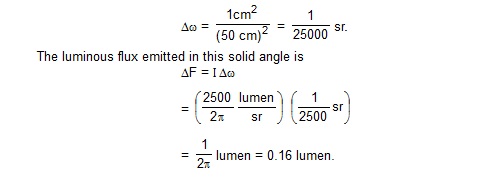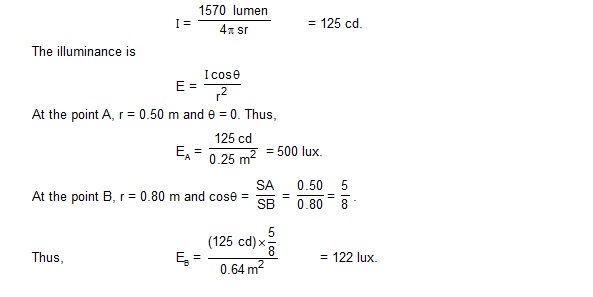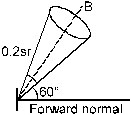Solved Examples
1. Find the luminous flux of a 10 W source of 600 nm. The relative luminously at 600 nm is 0.6.
Sol. The luminous flux of a 1 W source of 555 nm = 685 lumen. Thus, the luminous flux of a
10 W source of 555 nm = 6850 lumen. The luminous flux of a 10 W source of 600 nm is,
therefore,0.6 × 6850 lumen = 4110 lumen.
Questions for Short answer
1. What is the luminous flux of a source emitting radio waves?
2. The luminous flux of a 1 W sodium vapour lamp is more than that of a 10 kV source of ultraviolet radiation. Comment.
3. Light is incident normally on a small plane surface. If the surface is rotated by an angle of 30° about the incident light,
does the illuminance of the surface increase, decrease or remain same? Does your answer change if the light did not fall
normally on the surface?
4. A bulb is hanging over a table. At which portion of the table is illuminance maximum? If a plane mirror is placed above
the bulb facing the table, will the illuminance on the table increase?
5. The sun is less bright at morning and evening as compared to at noon although its distance from the observer is almost the same. Why ?
6. Why is the luminous efficiency small for a filament bulb as compared to a mercury vapour lamp?
7. The yellow colour has a greater luminous efficiency as compared to the other colours. Can we increase the illuminating
power of a white source by putting a yellow plastic paper around this source?
Objective - I
1. The one parameter that determines the brightness of a light source sensed by an eye is
(A) energy of light entering the eye per second
(B) wavelength of the light
(C) total radiant flux entering the eye
(D) total luminous flux entering the eye.
2. Three light sources A, B and C emit equal amount of radiant energy per unit time. The wavelengths emitted by the three
sources are 450 nm, 555 nm and 700 nm respectively. The brightness sensed by an eye for the sources are XA,
XB and Xc respectively. Then,
(A) XA > XB, XC > XB (B) XA > XB, XB > XC (C) XB > XA, XB > XC (D) XB > XA, XC > XB
3. As the wavelength is increased from violet to red, the luminosity.
(A) continuously increases (B) continuously decreases
(C) increases then decreases (D) decreases then increases
4. An electric bulb is hanging over a table at a height of 1 m above it. The illuminance on the table directly below the bulb is
40 lum. The illuminance at a point on the table 1 m away from the first point will be about
(A) 10 (B) 14 (C) 20 (D) 28
5. Light from a point source falls on a screen. If the separation between the source and the screen is increased by 1%, the
illuminance will decrease (nearly) by
(A) 0.5% (B) 1% (C) 2% (D) 4%
6. A battery-operated torch is adjusted to send an almost parallel beam of light. It produces an illuminance of 40 lux when
the light falls on a wall 2 m away. The illuminance produced when it falls on a wall 4 m away is close to
- (A) 40 lux (B) 20 lux (C) 10 lux (D) 5 lux
7. The intensity produced by a long cylindrical light source at a small distance r from the source is proportional to
(A) 1/r2 (B)1/r3 (C)1/r (D) none of these
8. A photographic plate placed at a distance of 5 cm from a weak point source is exposed for 3 s. If the plate is kept at a
distance of 10 cm from the source, the time needed for the same exposure is
(A) 3 s (B*) 12 s (C) 24 s (D) 48 s
9. A photographic plate is placed directly in front of a small diffused source in the shape of a circular disc. It takes 12 s to get
a good exposure. If the source is rotated by 60° about one of its diameters, the time needed to get the same exposure will be
(A) 6 s (B) 12 s (C*) 24 s (D) 48 s
10. A point source of light moves in a straight line parallel to a plane table. Consider a small portion of the table directly below
the line of movement of the source. The illuminance at this portion varies with its distance r from the source as

11. Figure shows a glowing mercury tube. the intensities at point A, B and C are related as

(A) B > C > A (B) A > C > B (C) B = C > A (D*) B = C < A
Objective - II
1. The brightness producing capacity of a source
(A) does not depend on its power (B) does not depend on the wavelength emitted
(C) depends on its power (D) depends on the wavelength emitted
2. A room it illuminated by an extended source. The illuminance at a particular portion of a wall can be increased by
(A) moving the source (B) rotating the source
(C) bringing some mirrors in proper positions (D) changing the colour of the source
3. Mark the correct options.
(A) The luminous efficiency of a monochromatic source is always greater than that of a white light source of same power.
(B) The luminous efficiency of a monochromatic source of wavelength 555 nm is always greater than that of a white light source of same power.
(C) The illuminating power of a monochromatic source of wavelength 555 nm is always greater than that of a white light source of same power.
(D) the illuminating power of a monochromatic source is always greater than that of a white light source of same power.
4. Mark the correct options.
(A) luminous flux and radiant flux have same dimensions
(B) luminous flux and luminous intensity have same dimensions
(C) radiant flux and power have same dimensions
(D) relative luminously is a dimensionless quantity
Worked Out Examples
1. A source emits 12.0 J of light of wavelength 620 nm and 8.0 J of light of wavelength 580 nm per second. The relative luminosity
at 620 nm is 35% and that at 580 nm is 80%. Find
(a) the total radiant flux,
(b) the total luminous flux and
(c) the luminous efficiency.
Sol.(a) The total radiant flux = total energy radiated per unit time = 12 J/s + 8 J/s = 20 J/s = 20 W.
(b) The luminous flux corresponding to the 12 W of 620 nm radiation is
0.35 × (12 W) × 685 lumen/W = 2877 lumen.
Similarly, the luminous flux corresponding to the 8W of 580 radiation is
0.80 × 10(8W) × 685 lumen/W =4384 lumen.
The luminous flux of the source is 2877 lumen + 4384 lumen
= 7261 lumen = 7260 lumen.
(c) The luminous efficiency = Total luminous flux/Total radiant flux = 2760lumen/20W
2. A circular area of radius 1.0 cm is placed at a distance of 2.0 m from a point source. The source emits light uniformly in all directions.
The line joining the source to the centre of the area is normal to the area. It is found that 2.0 × 10–3 lumen of luminous flux is incident
on the area. Calculate the total luminous flux emitted by the source and the luminous intensity of the source along the axis of area.
Sol. The solid angle subtended by the area on the point source is

3. The overall luminous efficiency of a 100 W electric lamp is 25 lumen/W. Assume that light is emitted by the lamp only in the
forward half, and is uniformly distributed in all directions in this half. Calculate the luminous flux falling on a plane object of
area 1 cm2 placed at a distance of 50 cm from the lamp and perpendicular to the line joining the lamp and the object.
Sol. The power input to the bulb = 100 W.
The luminous flux emitted by the bulb
= (25 lumen/W) × 100 W
= 2500 lumen.
Since light is emitted only in the forward half and is distributed uniformly in this half, the luminous intensity is


4. A point source emitting uniformly in all directions is placed above a table top at a distance of 0.50 m from it. The luminous flux
of the source is 1570 lumen. Find the illuminance at a small surface area of the table-top
(a) directly below the source and
(b) at the distance of 0.80 m from the source.
Sol. Consider the situation shown in figure. Let A be the point directly below the source S and B be the point at 0.80 m from the source.

The luminous flux of 1570 lumen is emitted uniformly in the solid angle 4p. The luminous intensity of the source in any direction is

5. The luminous intensity of a small plane source of light along the forward normal is 160 candela. Assuming the source to be perfectly
diffused, find the luminous flux emitted into a cone of solid angle 0.02 sr around a line making an angle of 60°C with the forward normal.

Sol. The situation is shown in figure. By Lambert’s cosine law, the intensity in the direction SB is
I = I0 cos 60°,
where I0 = 160 candela is the intensity along the forward normal.
Thus, I = (160 candela) (1/2)
= 80 candela.
The luminous flux emitted in the cone shown in the figure is
DeltaF = I delta x omega
= (80 canedela) (0.02 sr)
= 1.6 lumen.
Exercise
1. A source emits 45 joules of energy in 15 s. What is the radiant flux of the source?
Ans. 3 W
2. A photographic plate records sufficiently intense lines when it is exposed for 12 s to a source of 10 W. How long should
it be exposed to a 12 W source radiating the light of same colour to get equal intense lines?
Ans. 10 s
3. Using figure, find the relative luminosity of wavelength (a) 480 nm, (b) 520 nm (c) 580 nm and (d) 600 nm.
Ans. (a) 0.14 (b) 0.68 (c) 0.92 (d) 0.66
4. The relative luminosity of wavelength 600 nm is 0.6. Find the radiant flux of 600 nm needed to produce the same
brightness sensation as produced by 120 W of radiant flux at 555 nm.
Ans. 200 W
5. The luminous flux of monochromatic source of 1 W is 450 lumen/watt. Find the relative luminosity at the wavelength emitted.
Ans. 66%
6. A source emits light of wavelength 555 nm and 600 nm. The radiant flux of the 555 nm part is 40 W and of the 600 nm part is 30 W.
The relative luminosity at 600 nm is 0.6. Find (a) the total radiant flux, (b) the total luminous flux, (c) the luminous efficiency.
Ans. (a) 70 W (b) 39730 lumen (c) 568 lumen/W
7. A light source emits monochromatic light of wavelength 555 nm. The source consumes 100 W of electric power and emits 35
W of radiant flux. Calculate the overall luminous efficiency.
Ans. 240 lumen/W
8. A source emits 31.4 W of radiant flux distributed uniformly in all directions. The luminous efficiency is 60 lumen/watt.
What is the luminous intensity of the source?
Ans. 150 cd
9. A point source emitting 628 lumen of luminous flux uniformly in all directions is placed at the origin. Calculate the illuminance
on a small area placed at (1.0 m, 0, 0) in such a way that the normal to the area makes an angle of 37° with the X-axis.
Ans. 40 lux
10. The illuminance of a small area changes from 900 lumen/m2 to 400 lumen/m2 when it is shifted along its normal by 10 cm.
Assuming that it is illuminated by a point source placed on the normal, find the distance between the source and the area in the
original position.
Ans. 20 cm
11. A point source emitting light uniformly in all directions is placed 60 cm above a table - top. The illuminance at a point on the
table-top, directly below the source, is 15 lux. Find the illuminance at a point on the table top 80 cm away from the first point.
Ans. 3.24 lux
12. Light from a point source falls on a small area placed perpendicular to the incident light. If the area is rotated about the incident
light by a angle of 60°, by what fraction will the illuminance change?
Ans. it will not change
13. A student is studying a book placed near the edge of a circular table of radius R. A point source of light is suspended directly
above the centre of the table. What should be the height of the source above the table so as to produce maximum illuminance at the position of the book?
Ans. R/Ö2
14. Figure shows a small diffused plane source S placed over a horizontal table top at a distance of 2.4 m with its plane parallel to the table-top.
The illuminance at the point A directly below the source is 25 lux. Find the illuminance at a point B of the table at a distance of 1.8 m from A.
Ans. 6.1 lux
15. An electric lamp and a candle produce illuminance at a photometer screen when they are placed at 80 cm and 20 cm from the screen respectively.
The lamp is now covered with a thin paper which transmits 49% of the luminous flux. By what distance should the lamp be moved to balance the
intensities at the screen again?
16. Two light sources of intensities 8 cd and 12 cd are placed on the same side of a photometer screen at a distance of 40 cm from it. Where should a
80 cd source be placed to balance the illuminance?
Ans. 80 cm.